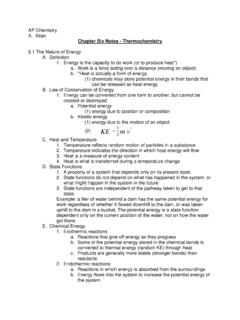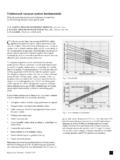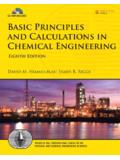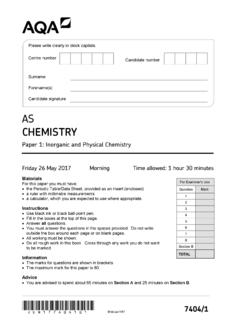Transcription of Oxford Cambridge and RSA AS Level Chemistry A - …
1 INSTRUCTIONS Use black ink. HB pencil may be used for graphs and diagrams. Complete the boxes above with your name, centre number and candidate number. Answer all the questions. Write your answer to each question in the space provided. If additional answer space is required, you should use the lined page(s) at the end of the booklet. The question number(s) must be clearly shown. Do not write in the The total mark for this paper is 70. The marks for each question are shown in brackets [ ]. Quality of extended responses will be assessed in questions marked with an asterisk (*). This document consists of 20 pages. OCR 2016 [601/5256/4]DC (RW/SW) 125460/6 Last nameFirst nameCandidatenumberCentrenumberOxford Cambridge and RSAAS Level Chemistry AH032/02 Depth in chemistryFriday 10 June 2016 AfternoonTime allowed: 1 hour 30 minutesYou must have: the Data Sheet for Chemistry A (sent with general stationery)You may use: a scientific calculator*6012828836*Turn overOCR is an exempt Charity*H03202*2 OCR 2016 Answer all the Group 2 elements are metals that react with oxygen and water.
2 (a) Magnesium is oxidised when it burns in oxygen to form an ionic compound. (i) Write the electron configuration, in terms of sub-shells, of a magnesium atom..[1] (ii) Explain what happens when magnesium is oxidised in terms of electron transfer..[1] (b) The trend in the first and second ionisation energies of Group 2 elements can be linked to the increase in chemical reactivity down the group. The first and second ionisation energies of calcium and strontium are given in the ionisation energy / kJ mol 1 Second ionisation energy / kJ mol 1Ca5901145Sr5501064 (i) Write an equation, including state symbols, to represent the second ionisation energy of strontium..[1] (ii) Explain why the first ionisation energy of strontium is less than the first ionisation energy of calcium.
3 [3]3 Turn over OCR 2016 (c) A student reacts a Group 2 metal, M, with (s) + 2H2O(l) M(OH)2(aq) + H2(g) The student measures the volume of hydrogen gas produced. g of the metal produces cm3 of gas measured at room temperature and pressure. (i) Draw a labelled diagram of the apparatus that can be used to carry out this experiment. [2] (ii) Identify the Group 2 metal, M. Show your working. Group 2 metal = ..[3] (d) The student plans to repeat the experiment using the same mass of a Group 2 metal from further down the group. Predict whether the volume of hydrogen produced would be greater than, less than or the same as the volume in the first experiment.
4 Explain your answer..[1]4 OCR 20162 The graph shows the melting points of the elements in Period 3 of the periodic number1516171819200400600800120014001600 18001000melting point/ KNaMgSClArSiAlP (a) Phosphorus and chlorine have simple molecular structures. More information about phosphorus and chlorine is given in the table formulaphosphorusP4chlorineCl2 Explain the differences in the melting points of phosphorus and chlorine..[3]5 Turn over OCR 2016 (b) Magnesium and silicon have different types of giant structures. Describe the bonding in magnesium and in silicon. Include the names of the particles and describe the forces between the particles in the structures..[4] (c) Aluminium forms a sulfide, Al2S3.
5 Al2S3 reacts with water to form aluminium hydroxide and hydrogen sulfide, H2S. Write an equation for the reaction of Al2S3 with water..[1]6 OCR 20163 Compound A is an ACCH3CH3CH3CH (a) The C=C bond in a molecule of compound A has restricted rotation because it comprises a bond and a bond. (i) Describe one difference between the bond and the bond..[1] (ii) Explain why compound A does not have E/Z isomers..[1] (iii) A structural isomer of compound A has E/Z isomers. Draw the structure of the Z isomer and then name this of Z isomer name .. [2]7 Turn over OCR 2016 (b) Compound A can be made from alcohol B by heating with an acid catalyst.
6 Suggest two possible structures for alcohol B. [2]8 OCR 2016 (c)* Compound A reacts with hydrogen bromide to form a mixture of two different organic ACCH3CH3CH3CH Give the structures of the two possible organic products of the reaction. Outline the mechanism, using the curly arrow model, for the formation of one of the organic products from compound A. Explain which of the two organic products is more likely to be formed..[6]9 Turn over OCR 2016 BLANK PAGEPLEASE DO NOT WRITE ON THIS PAGETurn over for the next question10 OCR 20164 Nitrogen forms several different oxides. N2O is a useful anaesthetic and NO has been linked to the depletion of ozone in the stratosphere. (a) The standard enthalpy changes of formation of N2O and NO are given in the fH / kJ mol 1N2O (g)+ (g)+ (i) Explain, in terms of bond breaking and bond making, why the enthalpy change of formation of NO is endothermic.
7 [1] (ii) Draw a fully labelled enthalpy profile diagram to represent the enthalpy change of formation of N2O. The formulae, with state symbols, of the reactants and products should be included as part of the diagram. You are not expected to show the activation energy for the of reaction [2]11 Turn over OCR 2016 (b) N2O is supplied as a compressed gas in steel cylinders for use as an anaesthetic. The cylinders are stored at C. Calculate the gas pressure, in Pa, in a dm3 steel cylinder containing 187 g of N2O gas. Give your answer in standard form to three significant figures. pressure = .. Pa [4] (c) NO radicals catalyse the breakdown of ozone in the stratosphere. Write two equations to show how NO radicals catalyse this breakdown.
8 [2]12 OCR 20165 A student investigates the reaction between strontium carbonate and dilute nitric + 2 HNO3 Sr(NO3)2 + CO2 + H2O The rate of reaction is determined from the loss in mass over a period of time. (a) (i) Explain why there is a loss in mass during the reaction..[1] (ii) An excess of strontium carbonate, SrCO3, is mixed with cm3 of mol dm 3 nitric acid, HNO3. Calculate the mass of SrCO3 that reacts with the HNO3. mass = .. g [3] (b) The student plots a graph of total mass (reagents + container) against / smass / g30035040013 Turn over OCR 2016 (i) Describe and explain the change in the rate of the reaction during the first 200 seconds of the experiment..[2] (ii) Using the graph, calculate the rate of reaction, in g s 1, at 200 seconds.
9 Show your working on the graph. rate of reaction = .. g s 1 [2] (c) Outline a method that could be used to obtain the results that are plotted on the graph. Your answer should include the apparatus required and the procedure for the experiment..[3]14 OCR 20166 This question is about the properties and reactions of Some properties of butan-2-ol are listed in the point 115 CBoiling C (a) Why is butan-2-ol classified as a secondary alcohol? ..[1] (b) The shape around the oxygen atom in butan-2-ol is non-linear. Predict the C O H bond angle and explain this angle ..explanation ..[4] (c) Butan-2-ol can be oxidised by heating with an oxidising agent. (i) Write an equation for the reaction.
10 Use [O] to represent the oxidising agent and show the structure of the organic product. [2]15 Turn over OCR 2016 (ii) A student plans to carry out this oxidation using the apparatus shown in the diagram. Give one reason why the apparatus is not suitable and describe a more suitable way of carrying out this oxidation..[2] (d) g of butan-2-ol is reacted with excess sodium bromide and sulfuric (OH)CH2CH3 + NaBr + H2SO4 CH3 CHBrCH2CH3 + NaHSO4 + H2O g of CH3 CHBrCH2CH3 is formed. Calculate the percentage yield of CH3 CHBrCH2CH3. percentage yield = .. % [3]16 OCR 20167* Organic compound C has the following percentage composition by mass: C, ; H, ; O, The infrared spectrum and mass spectrum of compound C are shown / cm 1transmittance(%)10005001020304050m / z02040relativeintensity608010060708090 In the mass spectrum, a secondary carbocation is responsible for the peak with the greatest relative OCR 2016 Identify compound C.

















